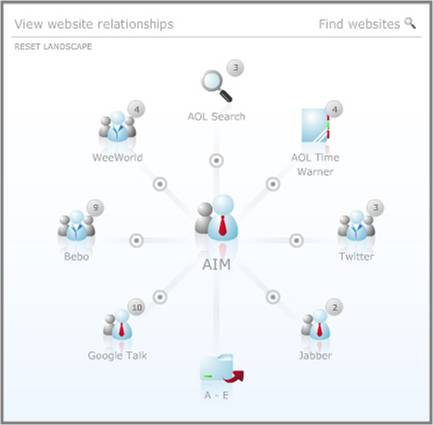SMP » About
Applications
Social Media Portal Landscape - Applications (apps)
Background
An application (app) in the widest term refers to a stand alone tool that performs a function, for example Microsoft Word is an application. A group of applications is called an application suite, an example of which is Microsoft Office.
When we refer to applications on the
Social Media Portal (SMP) we are referring specifically to a social media application. In this sense, an

application is a broad term for a social tool, whether it?s a plug-in or standalone, enabling interactivity and/or provides a service such as
Instant Messenger (IM), or an application on a social network such as
Facebook. Although an application, IM client and plug-in application differ widely in use, the technology and syndication they use are effectively part of the same family.
There are two key forms of applications,
web and
standalone.
A
web application is typically used and syndicated through a social networking site and developed with specific code.
A
standalone application (or desktop app) enables users to not be on a certain website, blog or similar before using the application ? these can be accessed via the desktop or internet browser. Standalone applications, such as IM clients, can be of a bigger size and therefore enable more functionality.
Platforms
The majority of social networking sites, handset manufacturers and mobile networks have developed their own application platform, which enables application developers to build apps specifically for the site, device and/or network.
With the growing popularity, there has been significant moves by key players in this area to make the application and
widget industry more collaborative ? meaning that developers can build applications that will work across mobile sites and services without needing to reinvent the wheel for each one.
In May 2007, popular social network Facebook launched its
Facebook Platform to provide a framework for software developers to develop applications. Facebook applications were designed to interact with other Facebook features and feedback information to the users profile news feed. Simultaneously, the company unveiled its
Facebook Markup Language so that it could keep the look and feel of applications developed for the site consistent. For launch, Facebook unveiled its own application suite, including Gifts, Marketplace, Events and Video. Today, there are over
950,000 registered developers and
52,000 applications available across the site.
Google launched
OpenSocial in November 2007 as set of common APIs that would enable developers to build applications that would work across multiple social networks. The launch wasn?t the hit it was expected, and in March 2008 Google
joined forces with
Yahoo!,
MySpace to launch the
OpenSocial Foundation. OpenSocial Foundation is a community driven platform to develop social applications, with other networks and companies joining quickly thereafter.
Social networking site
Bebo was one of the launch partners for OpenSocial when it launched in 2007, and it launched its own Developers Platform in December 2007. A year later, MySpace set up its own developer platform, and at launch had approximately 1,000 applications available.
Developments
With increased handset capabilities and lower network rates, applications
on mobile devices have soared over the twelve months. In June 2007, Apple announced that it would begin supporting applications developed by third parties for its iPhone but it wasn?t until February 2008 that the software development kit (SDK) was made available. Apple?s App Store has since seen over
one billion downloads.
SDKs have since been released by Google?s for the Android, Sony Ericsson for its X1 handset and Nokia launched its app store called Ovi in June 2009. The world?s largest mobile network Vodafone also announced that it will launch its own application platform, so that developers can build apps for the Vodafone network which will work across all supported handsets.
The benefits of adding your application to SMP
- Syndicate your application to a wider audience
- Reach brands, marketers and advertisers that are looking to connect with your target audience
- Connect with potential stakeholders, media and researchers raising the visibility of your app
- Update your stakeholders and target audiences with case studies, events, press releases and/or whitepapers about your software or technology
- Differentiate your approach, products, service and/or technology from your competitors
- Submit news scoops about your app through SMP to be considered for social media news
- List other assets of what your app possesses that relate to the social media Landscape and demonstrate the other relationships that it has
- Share your expertise through opinion and thought leadership articles published on the SMP site reaching your audiences
Have you built an app?
Become part of the SMP Landscape by
adding
your application.